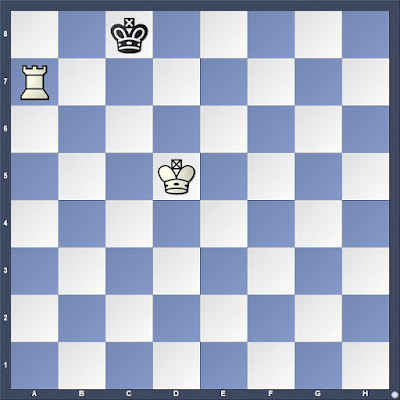Under ideal conditions, I would work with a small number of beginners and teach them the rudiments of the game with an emphasis on contacts (see "Lesson One"), as Momir Radovic advocates. In practice, however, when a large influx of students who have never played chess, or have recently learned the moves of the game, accommodating student needs and interests requires flexibility. Experience has taught me that students familiar with the game usually teach the others. It falls on me to teach some principles of tactics and strategy.
Our first meeting the first week of October, I took students through the geography of the chessboard, emphasizing ranks, files, diagonals, and the center. This first lesson concluded with an elementary checkmate demonstration based on one in José Raúl Capablanca, Chess Fundamentals (1921).
White to move
White wins quickest by first confining the Black king to the eighth rank.
1.Ra7
Then White's king moves up, staying on the same file as Black's king until time to move to the sixth rank.
1...Kg8 2.Kg2 Kf8 3.Kf3 Ke8 4.Ke4 Kd8 5.Kd5 Kc8
6.Kd6 Kb81.Ra7
Then White's king moves up, staying on the same file as Black's king until time to move to the sixth rank.
1...Kg8 2.Kg2 Kf8 3.Kf3 Ke8 4.Ke4 Kd8 5.Kd5 Kc8
White to move
If 6...Kd8, 7.Ra8# is checkmate.
7.Rc7 Ka8 8.Kc6 Kb8 9.Kb6 Ka8 10.Rc8#.
The second week featured another elementary checkmate.
White to move
From this position, checkmate can be forced in as few as fifteen moves. I did not display such efficiency while teaching this. Rather, I modeled thinking through the moves to 1) confine the king to a small area with the bishops controlling two parallel diagonals, 2) move White's king close, and 3) calculate the last few moves.
This morning, playing against Stockfish, I aimed for efficiency.
1.Bg5 Kf7 2.Bh3 Kg6 3.Bd8 Kf7 4.Ke2 Kg6 5.Kf3 Kf7 6.Kf4 Kg6 7.Be6 Kg7 8.Kg5 Kh7 9.Be7 Kg7 10.Bd6 Kh7 11.Bf8 Kh8 12.Kf6 Kh7 13.Kf7 Kh8 14.Bg7+ Kh7 15.Bf5# 1-0
Some miniatures (very short games) were shown illustrating quick checkmates because a player had weakened the short diagonal leading to the king. This unusual game, which appears as the first in Irving Chernev, The 1000 Best Short Games of Chess (1955), was followed by one from an online blitz game I had played.
Gibauld -- Lazard [A45]
Paris, 1924
1.d4 Nf6 2.Nd2 e5 3.dxe5 Ng4 4.h3 Ne3
White to move
White resigned as saving the queen with 5.fxe3, leads to 5...Qh4+ 6.g3 Qxg3#.
Internet Opponent -- Stripes,J [A45]
Live Chess Chess.com, 07.10.2021
1.d4 Nf6 2.Nd2 e5 3.dxe5 Ng4 4.Ngf3 d6 5.exd6 Bxd6 6.h3
Internet Opponent -- Stripes,J [A45]
Live Chess Chess.com, 07.10.2021
1.d4 Nf6 2.Nd2 e5 3.dxe5 Ng4 4.Ngf3 d6 5.exd6 Bxd6 6.h3
Black to move
6...Ne3 7.fxe3 Bg3#
Guiding theme of the lessons are few pieces, emphasizing the power of one of them, or short games with few moves. Efforts are made to explain the rules, including how each piece moves, checkmate, and stalemate. One of the short games provoked questions about castling.
A problem composed by Gioachino Greco about 1620 was shown to highlight two themes--forcing moves and a bishop on the wrong color squares.
Guiding theme of the lessons are few pieces, emphasizing the power of one of them, or short games with few moves. Efforts are made to explain the rules, including how each piece moves, checkmate, and stalemate. One of the short games provoked questions about castling.
A problem composed by Gioachino Greco about 1620 was shown to highlight two themes--forcing moves and a bishop on the wrong color squares.
Black to move
Black forces a draw via 1...Ra1+ 2.Rf1 Rxf1+ 3.Kxf1 Bh3
White to move
White can capture the bishop, and have two h-pawns or let the Black play 4...Bxg2. In either case, Black's king will find refuge on h8, moving between this square and either g8 or h7, depending on White's efforts. The h-pawn will never promote and White cannot win. Some time was expended demonstrating efforts White can make and how many lead to stalemate.During another session, an older composition was employed to highlight forcing moves and the power of pawns. This problem comes from a manuscript connected to Giulio Cesare Polerio, whose works influenced Greco.
White to move
1.Ng6+ hxg6 2.hxg6+ Nh6 3.Rxh6+ gxh6 4.g7+ Kh7 5.g6#All of Black's moves were forced.
The next lesson will feature another instructive exercise from manuscripts that are part of what historians call the Polerio-complex.
White to move
Themes include a partial stalemate (king cannot move, but there is a legal move). en passant, pawn promotion, and a checkmate pattern.






















No comments:
Post a Comment